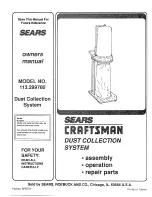
1.5HP Mobile Dust Cyclone Manual
9
Disconnecting power supply.
Turn the switch off, disconnect the dust collector from the
power supply, and allow the impeller to come to a complete stop before leaving the
machine unattended or doing any service, cleaning, maintenance, or adjustments.
Suspended dust particles and ignition sources.
Do not operate the dust collector in
areas where explosion risks are high. Areas of high
risk include, but are not limited to,
areas near pilot
lights, open flames, or other ignition sources.
Fire suppression.
Only operate the dust collector in locations that contain a fire
suppression system or have a fire extinguisher nearby.
Impeller hazards.
Do not place your hands or tools near the open inlet during operation
for any reason. The powerful suction could easily cause accidental contact with the
impeller, which will
cause serious personal injury or damage to the machine. Always keep small animals and
children away from open dust collection inlets.
Avoiding sparks.
Do not allow steel or rocks to strike the impeller
—
this may produce
sparks.
Sparks can smolder in wood dust for a long time before a fire is detected. If you
accidentally cut
Into wood containing tramp metal (nails, staples, spikes, etc.), immediately turn
off
the
dust collector, disconnect it from power, and wait for the impeller to stop
—
then empty the
collection container into an approved airtight metal container.
Operating location.
To reduce respiratory exposure to fine dust, locate permanently
installed dust collectors away from the working area, or in another room that is equipped
with a smoke detector. Do not operate the dust collector in rainy or wet locations
—
exposure to water may create a shock hazard or decrease the life of the machine.
Static electricity.
Plastic dust lines generate high amounts of static electricity as dust
chips pass through them. Although rare, sparks caused by static electricity can cause
explosions or fire. To reduce this risk, make sure all dust lines are thoroughly grounded by
using a grounding wire.
Regular cleaning.
Regularly check/empty the collection bags or drum to avoid the
buildup of fine dust that can increase the risk of fire. Make sure to regularly clean the
surrounding area where the machine is operated
—
excessive dust buildup on overhead
lights, heaters, electrical panels, or other heat sources will increase the risk of fire.
SAVE THESE INSTRUCTIONS.
Refer to them often and use them to instruct others.
Summary of Contents for PFLUX1
Page 12: ...1 5HP Mobile Dust Cyclone Manual 11 Figure 2 110 Volt Internal Wiring ...
Page 35: ...1 5HP Mobile Dust Cyclone Manual 34 220 Volt Wiring Diagrams Figures 21 22 OPERATION ...
Page 44: ...1 5HP Mobile Dust Cyclone Manual 43 Figure 48 Fan Motor Switch SECTION A Close up view ...
Page 45: ...1 5HP Mobile Dust Cyclone Manual 44 Figure 49 Cyclone Canister Barrel SECTION B Close up view ...
Page 46: ...1 5HP Mobile Dust Cyclone Manual 45 Figure 50 Panels Lock SECTION C Close up view ...
Page 47: ...1 5HP Mobile Dust Cyclone Manual 46 Figure 51 Barrel insert SECTION D Close up view ...































